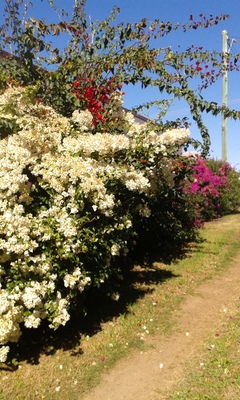I love to look at bougainvilleas.
I have never grown them but have lived where they came over the fence and really was in awe of the thorns!
They are a beautiful creeper but are not for everyone, and can be grown as a ground cover, as a climber or trained as a tree and really look spectacular.
They can be grown quite successfully in pots as there is now a whole range of dwarf varieties and those with variegated foliage. The colour range is huge from white through creams, pinks, oranges and red to all shades of mauve to the deep purple that is the original and common variety and the one with the huge, vicious thorns that I remember.
They even come in bi-colours and are really very beautiful.
The bright colourful “flowers” that we admire are in reality bracts surrounding the insignificant tiny white or cream flowers.
They are native to the tropics and sub tropics of South America and are named in honour of the explorer and scientist Louis Antoine de Bougainville (1729-1811) who made the first French circumnavigation of the world.
They will grow in many areas and some will tolerate light frosts once established. They are hardy and drought tolerant but do require water to flower well. There are some really spectacular bushes growing in private gardens in Warwick against buildings which would provide some shelter from frosts.
They can be grown very readily from cuttings and can be pruned to remain small and compact and make a very colourful and eye-catching hedge.
Prune the branching canes as they appear and this will keep them compact and contained and minimise the risk of getting spiked by those vicious thorns.
Regular light pruning is the best method of control but it is best to refrain from pruning once the flowers begin to appear.
They do make spectacular flowering trees and the pruning method to achieve this shape can be found on the Internet but I doubt that this could be achieved in the Warwick climate. and I am certainly not tall enough to be able to keep the escaping branches pruned into submission.
A favourite plant of a good friend of mine is the wallflower which is an old-fashioned plant that is not so readily available these days. The flowers looks a bit like a single stock, are often richly perfumed and yellow, autumn coloured or purple, although with hybrids the colour range is extensive these days.
They are an evergreen, hardy, annual, perennial or sub shrub and are a member of the cabbage family and are native to Europe, western Asia and western North America.
Annuals are raised from seed while perennials are propagated from cuttings of non-flowering stems. While they are drought tolerant they will reward with an abundance of flowers if regularly watered particularly if this is combined with feeding, dead heading and trimming. If perennials become woody they should be cut back quite hard to revitalise the plant.
The old name for these was Cheiranthus, meaning hand flower and refers to the habit from the middle ages of carrying some in the hand to ward off the many unpleasant smells of the cities and towns. While they prefer alkaline soil they also tolerate poor soil well and do not like wet feet.
It would seem that so long as the soil is free draining they will do well and do not like too much fertiliser.
They are traditionally planted as an accompaniment to tulips so now is the right time to plant them.
Camellias are also flowering well now and on a recent trip through Maleny I was treated to a spectacular sight of Sasanqua hedges in full flower and the added treat of the ground carpeted with the fallen flowers.
They have the advantage over other camellias in that they tolerate full sun as well as partial shade. They can be grown in the garden or in pots and as long as they are planted into good soil and mulched correctly they are one of the most drought tolerant plants about and will reward with a spectacular show of their beautiful single or semi double flowers in a colour range from white through all pinks to deep red.
Don’t forget the free information evening to be hosted by the Horticultural Society on Wednesday evening 31 May in the CWA rooms in Grafton Street.
The evening will start promptly at 7pm and conclude at 9pm followed by supper.
There will be plenty of time for questions to our presenters Heather and Noel Prior from Brisbane.
Anyone involved or interested in floral art or showing flowers or plants will benefit greatly from the Priors’ expertise.
See you there!







